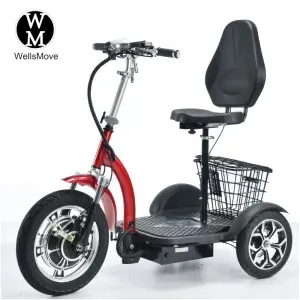How to Choose Disabled Three Wheel Mobility Trike Scooter for Your Market
Introduction
Choosing the right disabled three-wheel mobility trike scooter for your market is a critical decision that can significantly impact your business success. The wrong choice can lead to dead stock and wasted capital, hurting your cash flow and reputation. To make the right decision, you need to understand your market’s demographics, match technical specifications to user needs, and align your product with your distribution channel and price position.
Understanding Your Market Demographics
Key Demographic Segments
To choose the right mobility scooter, you must first analyze your market’s key demographics, such as age and typical use cases. The primary market segments for disabled three-wheel mobility trike scooters are:
Demographic Segment Primary Need Typical Scooter Features
Elderly (65+) Safety, Stability, Simplicity 3 or 4 wheels, comfortable seat, intuitive controls
Users with Disabilities Reliability, Accessibility High weight capacity, long battery life, custom options
Younger/Active Users Portability, Performance 3 wheels for maneuverability, lightweight, foldable design
Institutional Users Durability, Low Maintenance Solid tires, simple electronics, robust frame
User Groups and Their Primary Needs
Elderly (65+): This group prioritizes safety and stability. They typically need scooters with comfortable seats, intuitive controls, and a maximum speed of around 5 miles per hour. For example, in Japan and parts of Europe, where the aging population is large, models with extra comfort features and enhanced safety ratings are often requested.
Users with Disabilities: These individuals require reliable daily mobility. They need scooters with high weight capacity, long battery life, and customizable options to meet their specific needs.
Younger/Active Users: This growing segment includes younger individuals with temporary injuries or chronic conditions. They look for portable, lightweight, and foldable designs that can be easily maneuvered in tight spaces.
Institutional Users: Facilities like hospitals and retirement communities need durable, low-maintenance scooters that can withstand frequent use
Technical Specifications and Market Positioning
Key Specifications
The technical specifications of a mobility scooter can significantly impact its market positioning and buyer selection. Here are the most important specs to consider:
Specification Option A (Lower Cost) Option B (Higher Performance) Best For…
Wheels 3-Wheel 4-Wheel Indoor maneuverability (A) vs. Outdoor stability (B)
Battery Lead-Acid Lithium-Ion Budget-conscious buyers (A) vs. Portable/Long-life needs (B)
Motor Power 250W – 350W 500W+ Flat terrain, indoor use (A) vs. Hills, heavy users (B)
Tires Solid / Puncture-Proof Pneumatic / Air-Filled Low maintenance, smooth surfaces (A) vs. Maximum comfort, all-terrains (B)
Matching Specifications to User Needs
3-Wheel vs. 4-Wheel: 3-wheel scooters offer better maneuverability in tight spaces, making them ideal for indoor use. 4-wheel scooters provide greater stability, especially on uneven terrain, making them better suited for outdoor use.
Battery Type: Lead-acid batteries are cheaper upfront but heavier and have a shorter lifespan. Lithium-ion batteries are more expensive but lighter and last longer, making them ideal for portable scooters.
Motor Power: For flat terrain and indoor use, a motor power of 250W to 350W is sufficient. For hills and heavy users, a more powerful motor (500W+) is recommended.
Tires: Solid tires are low maintenance and suitable for smooth surfaces. Pneumatic tires offer better comfort and are ideal for all-terrain use.
Distribution Channels and Government Procurement
Main Distribution Channels
Once you have sourced a great product, you need to get it to the end-user. The main distribution channels for disabled three-wheel mobility trike scooters include:
Specialized Healthcare Equipment Distributors: These distributors focus on medical and mobility products and can provide valuable support in terms of sales and after-sales service.
E-commerce Platforms: Online platforms like Amazon offer a wide reach and can be an effective way to sell to individual consumers.
Direct B2B Sales: Selling directly to facilities like airports, retirement communities, and hospitals can provide stable, large-volume orders.
Government Procurement Opportunities
Government contracts offer a significant opportunity for large, stable orders. However, they require strict adherence to certifications and quality standards. For example, a client from Morocco bidding on a government tender for a disability support program needed CE certification, a specific turning radius, minimum battery range, and extensive documentation on spare part availability. If you are targeting government contracts, ensure your product meets all specified requirements.
Balancing Cost, Quality, and Market Positioning
Finding the Value “Sweet Spot”
Competing solely on price is not sustainable. Instead, you need to find the value “sweet spot” that meets your customers’ needs and your market’s price point. Here’s how to balance cost, quality, and market positioning:
Budget & Portable: For price-sensitive markets, focus on lightweight, foldable designs with standard features. Use cost-effective components like lead-acid batteries to keep the retail price around $700-$1,500.
Mid-Range All-Rounder: Offer a balance of features and price. Include good range, 3 or 4 wheels, and some comfort features to appeal to a broader audience. Aim for a retail price of around $1,500-$2,500.
Premium & Heavy-Duty: For markets that demand high performance and are willing to pay for it, design robust scooters with powerful motors, high-capacity lithium batteries, and premium features. These models can command retail prices of $2,500 or more.
Market Position and Product Focus
Market Position Target Customer Key Features Factory Focus
Budget & Portable Price-conscious, needs portability Lightweight, foldable, simple controls Cost control, lead-acid battery
Mid-Range All-Rounder Seeks balance of features & price Good range, 3 or 4 wheels, some comfort Versatile design, popular features
Premium & Heavy-Duty Needs performance, has higher budget High weight capacity, long-range, full suspension Durability, lithium battery, safety
Practical Tips for Choosing the Right Scooter
Considerations for Different User Groups
Elderly Users: Prioritize safety and ease of use. Look for scooters with comfortable seats, intuitive controls, and a maximum speed of around 5 miles per hour.
Users with Disabilities: Focus on reliability and accessibility. Ensure the scooter has a high weight capacity, long battery life, and customizable options to meet specific needs.
Younger/Active Users: Emphasize portability and performance. Choose lightweight, foldable designs with 3 wheels for better maneuverability.
Institutional Users: Opt for durability and low maintenance. Look for solid tires, simple electronics, and a robust frame to withstand frequent use.
Additional Tips
Test Ride: If possible, always test ride the scooter to ensure it meets the user’s needs and expectations.
Customization: Consider customization options such as adjustable seats and handlebars to enhance comfort and control.
Maintenance: Ensure the scooter is easy to maintain and that spare parts are readily available.
Conclusion
Choosing the right disabled three-wheel mobility trike scooter for your market involves a thorough understanding of your target audience, matching technical specifications to user needs, selecting the appropriate distribution channels, and finding the right balance between cost and quality. By following these steps, you can ensure that the scooters you import meet the specific needs of your market, leading to a successful and sustainable business.
Post time: Aug-01-2025



